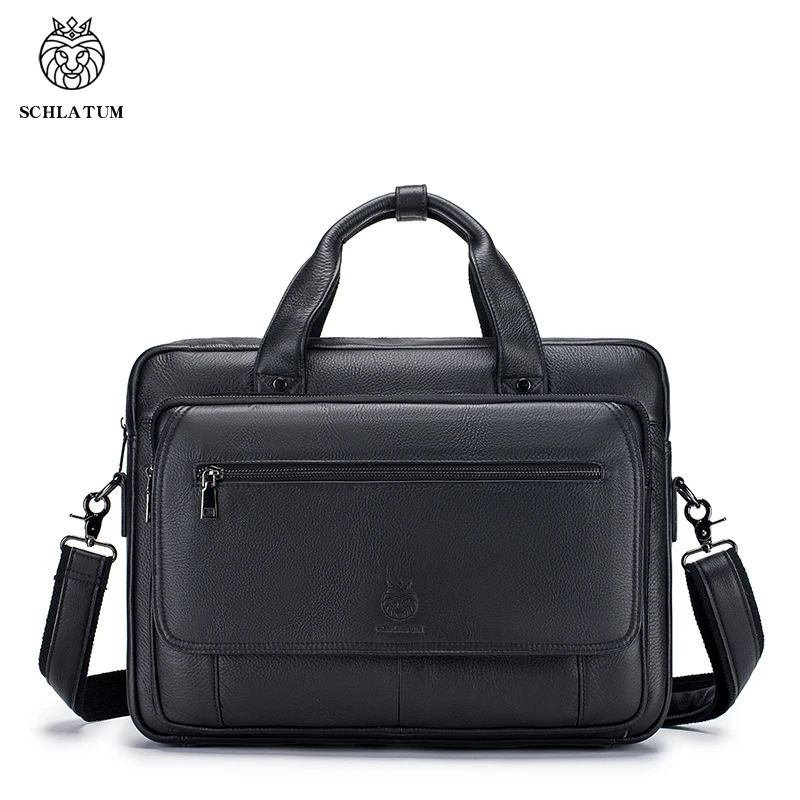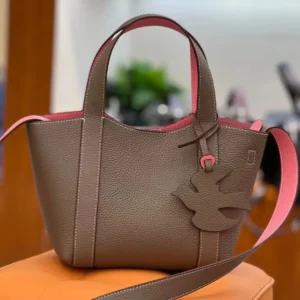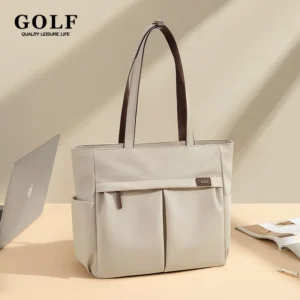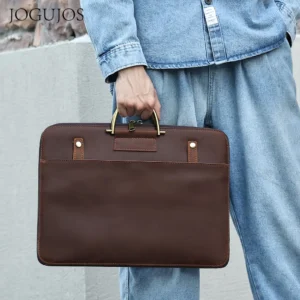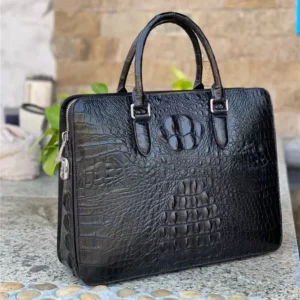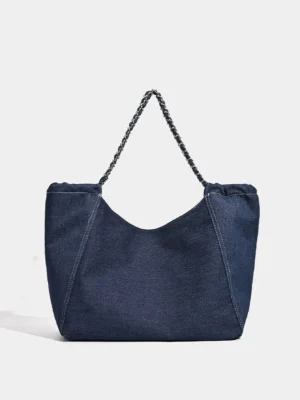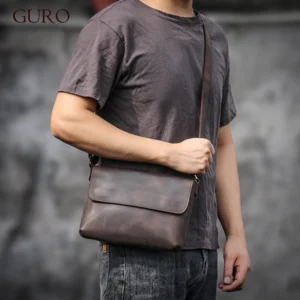Introduction: The Enduring Debate Between Brown and Black Leather
Few style decisions spark as much contemplation as choosing between black and brown leather. Whether you’re investing in a briefcase, selecting shoes, or buying a belt, this color choice shapes not just your immediate appearance but also the long-term versatility of your purchase.
The debate transcends mere fashion preference—it touches on personal identity, professional image, and practical considerations. Both colors have distinct personalities that communicate different messages in various contexts. While black leather projects authority and sleek modernity, brown leather conveys warmth and classic refinement.
Throughout history, these two leather colors have dominated both fashion and function. Kings and military leaders often chose black for its formality and power, while explorers and craftsmen frequently selected brown for its natural character and ability to hide wear.
In this guide, we’ll examine the unique attributes of both colors, explore their suitability for different items, and provide practical advice for choosing timeless classic leather briefcase options and other leather goods. The reality? Neither color is universally “better”—each excels in different contexts, and understanding these nuances helps you make more informed decisions.
Understanding the Essential Characteristics of Leather Colors
The color of leather fundamentally transforms its character, versatility, and visual impact. This transformation goes far deeper than mere appearance—it influences how the material ages, pairs with other items, and fits within various settings.
The dyeing process significantly affects leather’s final presentation. Black leather typically undergoes more intensive dyeing to achieve its deep, consistent color. This process often creates a uniform appearance that masks the natural grain variations. Brown leather, by contrast, frequently undergoes less intensive coloring, allowing more of the natural characteristics and imperfections of the hide to remain visible, creating depth and character.
Different finishes interact uniquely with each color. High-gloss finishes on black leather create dramatic shine and formality, while the same treatment on brown leather produces a rich, multidimensional luster. Matte finishes give black leather a subtle sophistication, whereas they enhance brown leather’s natural, earthy qualities.
In premium defining best leather briefcases and other goods, the quality of full-grain leather expresses itself differently depending on the color. Black presents a consistent canvas that emphasizes form and structure. Brown reveals the natural beauty of the material itself, highlighting unique grain patterns and developing a distinctive patina over time.
The Black Leather Identity: Sophistication with Edge
Black leather embodies authority, precision, and timeless elegance. Its sleek appearance creates clear lines and strong silhouettes, communicating confidence and decisiveness. In professional environments, black leather carries an inherent formality that seamlessly transitions from boardroom to evening events.
The psychological impact of black leather is unmistakable—it projects power, sophistication, and urban savvy. This explains why it remains the default choice for executive environments and formal occasions. The color creates immediate visual definition, allowing leather goods to make strong statements against any backdrop.
Historically, black leather has played dual roles in fashion and culture. In professional settings, it represents establishment and authority—seen in executive briefcases and formal footwear throughout the decades. Simultaneously, it carries rebellious undertones through its association with motorcycle culture and rock aesthetics.
The clarity and definition of black leather briefcase options create striking contrast in professional attire, allowing these pieces to serve as anchoring elements in an outfit. The color’s universal recognition as formal and sophisticated makes it particularly valuable for situations where making a strong first impression matters.
The Brown Leather Personality: Warmth with Character
Brown leather exudes warmth, versatility, and approachable sophistication. It carries an inherent connection to tradition and craftsmanship, projecting reliability and timeless style rather than fleeting fashion. The color evokes natural elements and historical craftsmanship, creating an immediate sense of authenticity and substance.
The psychological effect of brown leather centers on accessibility and trustworthiness. It suggests someone who values quality and longevity over trends, who appreciates subtle details rather than obvious status symbols. This approachable sophistication makes brown leather briefcase styles particularly appealing in creative industries and business-casual environments.
What truly distinguishes brown leather is its remarkable spectrum of shades. From light tan and caramel to rich cognac and deep chocolate, each variation creates a distinct impression. Lighter browns project casual versatility, medium browns convey classic professionalism, and darker browns approach the formality of black while maintaining brown’s characteristic warmth.
The most distinctive quality of brown leather is how it develops character over time. Unlike black leather, which tends to maintain its uniform appearance, quality brown leather develops a rich patina—a natural luster that tells the story of its use. This aging process transforms brown leather goods from mere accessories into personal artifacts that become more uniquely yours with each passing year.
The Definitive Comparison: Black vs. Brown Leather Attributes
When comparing these two classic options, several key factors determine which color better suits specific needs and preferences.
On the formality spectrum, black leather occupies the most formal position in traditional settings. It remains the standard for black-tie events, formal business environments, and evening functions. Brown leather spans a broader range, with darker shades appropriate for most business settings and lighter tones perfectly suited for smart-casual and weekend wear. This versatility gives brown an edge for those seeking maximum flexibility from a single item.
For wardrobe coordination, black leather pairs seamlessly with grayscale colors, navy, and most cool tones. It creates sharp definition and formal structure within an outfit. Brown leather harmonizes beautifully with warm colors, earth tones, and many vibrant hues. This broader pairing potential often makes brown the more versatile choice for those with diverse wardrobes.
Each color makes a distinct aesthetic statement. Black projects urban sophistication, authority, and modern minimalism. It draws attention to the form and design of the item rather than the material itself. Brown communicates heritage quality, natural authenticity, and classic style. It highlights the material’s organic qualities and craftsmanship.
The aging process differs significantly between colors. Black leather typically shows scratches and wear more visibly, often requiring more careful maintenance to maintain its uniform appearance. Brown leather generally displays wear more gracefully, with scratches and handling marks often enhancing its character rather than detracting from it. This gives brown an advantage for items that will see heavy daily use.
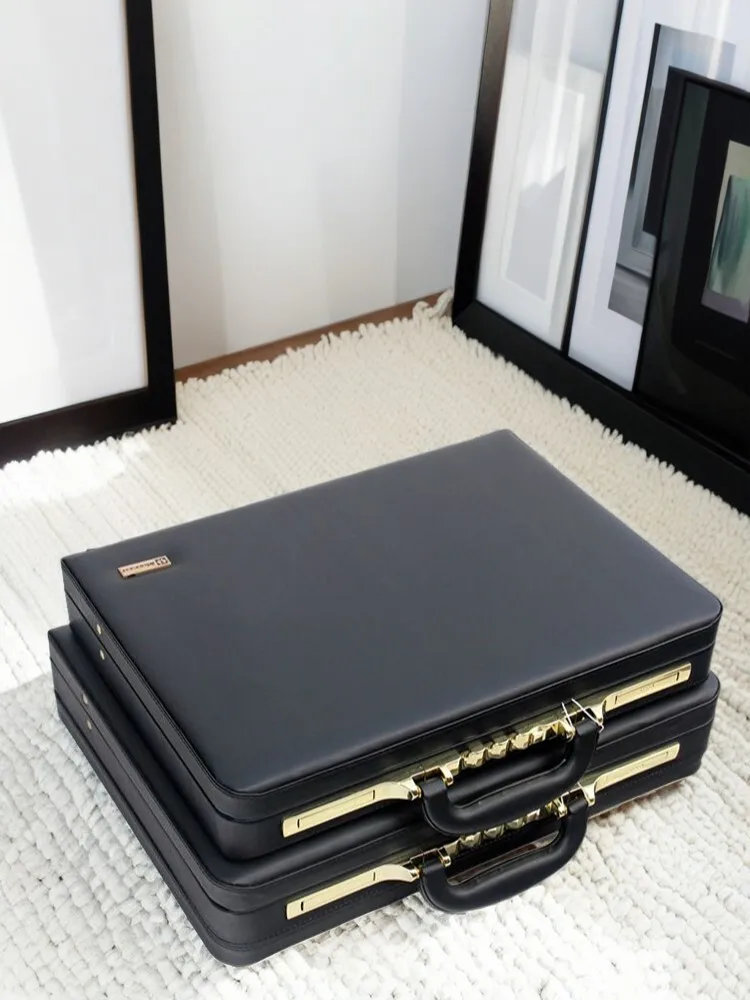
For maintenance considerations, black leather often shows dust and lighter scuffs more readily but conceals minor stains better than light brown shades. Brown leather, particularly in mid-tones, typically forgives everyday wear more gracefully but may require occasional conditioning to maintain its rich color. These maintenance differences matter most for items you’ll use frequently, like black brown leather briefcase men carry daily.
Item-Specific Guide: Choosing Between Black and Brown Leather
The “better” leather color varies significantly depending on the specific item, its intended use, and your personal style. While general principles apply across categories, each leather good has unique considerations that influence the ideal color choice.
Your existing wardrobe, professional environment, and personal aesthetic should guide these decisions. A finance professional with mostly navy and gray suits might benefit most from black leather accessories, while a creative director with a diverse wardrobe might find brown leather offers greater versatility.
Quality remains paramount regardless of color—premium construction, excellent materials, and thoughtful design matter more than color for long-term satisfaction with any leather purchase. The black brown professional briefcase options that serve professionals best are those combining appropriate color with outstanding quality.
Leather Bags and Briefcases: Professional Statements
In professional settings, your bag makes an immediate statement about your personal brand and attention to detail. Black leather briefcases project formal authority and executive presence—making them ideal for traditional business environments like finance, law, and corporate leadership. They create clean lines against dark business suits and maintain a consistent professional image.
Brown briefcases, particularly in darker shades like chocolate or cognac, offer professional appropriateness with added versatility. They transition more seamlessly between formal meetings and casual settings, pairing effectively with both suits and business-casual attire. This adaptability makes brown an excellent choice for professionals with varied daily environments.
Industry norms significantly influence which color works best. Conservative fields typically favor black leather’s formality, while creative industries often embrace brown’s character and individuality. For those working across multiple environments, consider your most formal regular setting as the benchmark—you can always dress down a formal bag, but you can’t always dress up a casual one.
Hardware color also affects your choice—silver or platinum-colored hardware traditionally pairs with black leather for maximum formality, while brass or gold-toned hardware complements brown leather’s warmth. The classic laptop briefcase collection demonstrates how these details work together to create cohesive professional accessories.
Leather Shoes: The Foundation of Your Style
Shoes establish the formality level of your entire outfit, making color choice particularly significant. Traditional style conventions hold that black leather shoes are essential for formal events, black-tie occasions, and the most conservative business environments. They remain the standard for formal evening wear and pair naturally with black, gray, and navy suits.
Brown leather shoes offer substantially more versatility across casual and business-casual settings. They complement khakis, jeans, and colored trousers beautifully while still working with many suit colors (particularly blue, gray, and brown). The range of brown tones creates additional flexibility—light tan for casual settings, medium brown for versatility, and dark brown approaching black’s formality.
Different shoe styles have their own color conventions. Oxford dress shoes remain most formal in black, while wingtips and brogues often appear more balanced in brown due to their detailed styling. Loafers and boat shoes typically feel more natural in brown tones, though black loafers serve formal business needs effectively.
The traditional rule of matching leather shoes to belts and other accessories still holds value for creating cohesive looks, though contemporary styling allows more flexibility. For maximum versatility, having at least one quality pair in each color provides options for any situation.
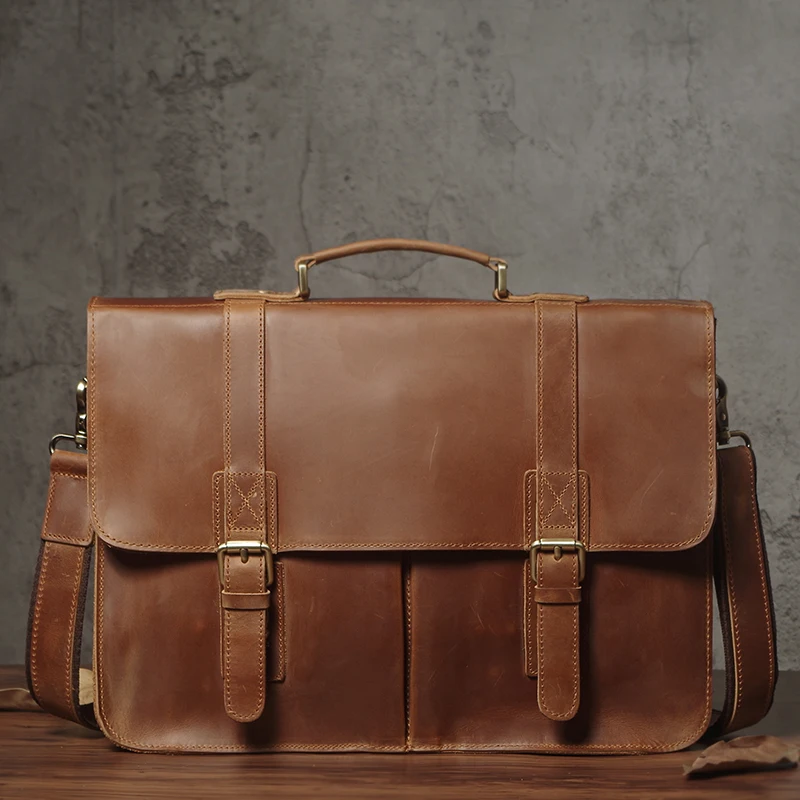
Leather Jackets: Making a Statement
Few items make as bold a statement as a leather jacket, with color significantly influencing its character. The iconic black leather jacket projects urban edge, timeless cool, and subtle rebellion. It creates striking contrast against most clothing and offers versatile pairing with many colors. This option works particularly well for evening wear and metropolitan settings.
Brown leather jackets evoke vintage aesthetics, outdoor heritage, and approachable style. They typically appear less severe than black alternatives while offering exceptional versatility with casual wardrobes. The professional leather briefcases guide demonstrates how these color principles apply across leather categories.
Styling approaches differ between colors. Black leather jackets pair powerfully with monochromatic outfits and dark denim for sleek urban looks. Brown jackets complement earth tones, textured fabrics, and casual layering for a more relaxed, timeless appearance. Both work with jeans, though brown often creates more harmonious casual combinations.
Seasonal considerations also influence this choice. Black leather maintains its relevance year-round and integrates well with winter wardrobes. Brown leather often feels more seasonally versatile, harmonizing beautifully with fall colors while remaining appropriate through spring.
Leather Accessories: The Details That Define Style
Small leather goods make subtle but important contributions to your overall appearance. Wallets, belts, watch straps, and other accessories connect different elements of your outfit and reflect attention to detail.
The traditional guideline of matching leather accessories to your shoes still provides a reliable approach for formal settings. Black shoes call for black belts and ideally black leather watch straps in business and formal environments. This coordination creates visual harmony and projects thoughtful precision.
Brown accessories offer greater flexibility across casual and business-casual settings. They complement a wider range of clothing colors and generally appear less severe than black alternatives. The varied tones of brown leather allow for subtle coordination even when shades don’t exactly match.
When mixing leather colors, intention matters more than strict rules. Deliberately contrasting black shoes with a brown bag can work when the overall outfit supports this division. However, accidentally mismatched leather often appears careless rather than stylish. The leather messenger bags that work best in professional settings typically align with your other leather accessories.
Mastering the Art of Styling Leather Colors
Building outfits around leather items requires understanding how these colors interact with the rest of your wardrobe. Black leather creates strong contrast and formal structure, anchoring outfits built around white, gray, navy, and cool-toned colors. Its definitive lines work particularly well with tailored clothing and modern silhouettes.
Brown leather harmonizes with warm colors, earth tones, and textured fabrics. It pairs beautifully with cream, tan, olive, burgundy, and denim, creating cohesive looks that feel both refined and approachable. This natural compatibility makes brown exceptionally versatile for business-casual and smart-casual environments.
Seasonal considerations also influence leather color styling. Black leather maintains consistent relevance throughout the year and transitions seamlessly from day to evening. Brown leather often feels most harmonious with fall and spring palettes but works year-round when paired thoughtfully.
For maximum versatility, the classic leather briefcase comparison shows how both colors can serve as foundation pieces in a professional wardrobe. Having key items in both colors ultimately provides the greatest flexibility across all situations.
The Modern Approach: Can You Mix Black and Brown Leather?
Traditional style rules firmly discouraged mixing black and brown leather, considering it a fundamental fashion mistake. This convention stemmed from formal dress codes where matching leathers created visual harmony and demonstrated attention to detail.
Contemporary styling has largely relaxed this restriction, recognizing that intentional mixing can create sophisticated, layered looks. The key word is “intentional”—successful mixing requires purpose rather than accident.
For effective combination, maintain sufficient separation between the different leather items. Black shoes and a brown bag work better when they aren’t directly adjacent in your outfit. Creating deliberate contrast often proves more successful than having similar but not-quite-matching browns.
Some combinations work more effectively than others. Dark brown and black pair more harmoniously than light brown and black due to their closer color values. Style guide tan black leather approaches provide specific guidance for successful combinations.
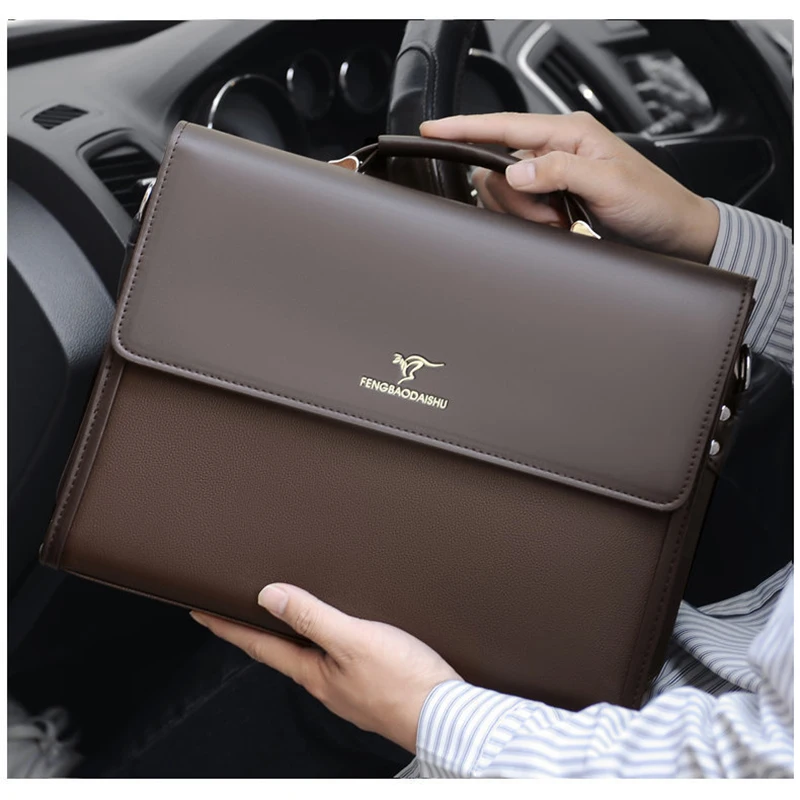
Making Your Decision: Practical Factors to Consider
When choosing between black and brown leather, consider these practical factors:
Your existing wardrobe should guide your decision. Assess whether your clothing leans toward cool tones (blues, grays, blacks) or warm tones (browns, greens, burgundies). Black leather typically complements the former, while brown harmonizes with the latter.
Professional environment expectations matter significantly. Traditional corporate settings and formal industries often favor black leather’s authority, while creative fields and business-casual environments welcome brown’s versatility and character.
Consider your personal style identity and aesthetic goals. If your style centers on urban sophistication, minimalism, or high contrast, black leather often aligns better. If you prefer classic heritage looks, natural textures, or versatile combinations, brown frequently proves more compatible.
Maintenance requirements and lifestyle should influence your choice. If you need something that maintains a pristine, uniform appearance with minimal attention, black often works better for structured formal pieces. If you appreciate items that develop character over time and forgive occasional marks, brown typically offers these qualities.
The best leather color work bag for your specific situation emerges from these considerations rather than any universal rule.
Beyond Basic: Exploring Other Premium Leather Colors
While black and brown dominate the leather landscape, several sophisticated alternatives deserve consideration. Burgundy (sometimes called oxblood or cordovan) offers formal elegance with distinctive character. Its deep, rich tone works beautifully in professional environments while providing more personality than black and nearly as much versatility as dark brown.
Navy leather provides formal structure with subtle distinction. In briefcases and formal shoes, navy offers professional appropriateness with a contemporary edge that sets it apart from more common options. It pairs exceptionally well with blue, gray, and tan clothing.
Gray leather delivers modern sophistication and remarkable versatility. In briefcases and accessories, gray creates a contemporary professional statement without the starkness of black. It harmonizes with virtually any color palette, making it an exceptionally adaptable choice.
These alternatives often work best once you’ve established basics in black and brown, allowing you to expand your collection with distinctive options that still maintain professional appropriateness. Leather work totes in these alternative colors often provide functional versatility with distinctive style.
Brown Leather Work Tote, Large Leather Work Tote
$194.38 Select options This product has multiple variants. The options may be chosen on the product pageLeather Laptop Work Tote, Tan Leather Work Tote, Women's Leather Work Tote, Zippered Leather Work Tote
Price range: $223.62 through $237.97 Select options This product has multiple variants. The options may be chosen on the product pageClassic Laptop Briefcase, Men's Classic Leather Briefcase, Slim Leather Attache Case
Price range: $353.50 through $360.81 Select options This product has multiple variants. The options may be chosen on the product pageBlack Leather Briefcase, Leather Document Bag, Men's Classic Leather Briefcase
Genuine Crocodile Leather Executive Briefcase with Password Lock – Premium Business Document Carrier$1,201.87 Select options This product has multiple variants. The options may be chosen on the product pageCanvas & Leather Messenger Bag, Leather Commuter Tote
$80.41 Select options This product has multiple variants. The options may be chosen on the product pageCrazy Horse Leather Satchel, Men's Leather Satchel, Men's Professional Leather Messenger, Vintage Style Messenger Bag
$132.70 Select options This product has multiple variants. The options may be chosen on the product page
Final Verdict: Choosing Between Black and Brown Leather
After examining the attributes of both leather colors across various contexts, several clear patterns emerge. Black leather excels in formal business environments, evening occasions, and situations demanding clear authority. Its uniform appearance and sharp definition make it particularly valuable for structured professional items like formal briefcases and dress shoes.
Brown leather offers superior versatility across casual and business-casual settings. Its natural warmth and character development make it exceptional for items that see frequent daily use. The spectrum of brown shades provides options ranging from casual tan to formal dark brown, allowing strategic selection based on your specific needs.
For those building a leather collection, consider your most common environments when choosing your first investment pieces. Those in formal business settings might start with black essentials before adding brown options. Those in variable or creative environments might find brown provides greater initial versatility.
Remember that regardless of color, quality construction and materials determine how well your leather goods serve you over time. Premium full-grain leather in either color will far outperform inferior materials, developing character and providing satisfaction for years to come.
Expert Answers: Frequently Asked Questions
Is black or brown leather more versatile for professional use?
It depends on your industry and dress code. Black offers greater formality for traditional corporate environments, while brown provides more versatility across business-casual and creative professional settings. Dark brown approaches black’s formality while offering broader pairing options.
Which color leather ages better or shows wear less?
Brown leather typically develops patina and character more gracefully, with scratches and wear often enhancing its appearance. Black leather maintains its uniform look longer but tends to show scratches more visibly when they occur. Mid-tone browns generally forgive everyday wear most effectively.
Which leather color is better for a first investment piece?
Choose based on your most common environment. For formal business settings, black typically serves better as a first investment. For varied environments or business-casual dress codes, dark brown often provides maximum versatility.
Should leather accessories always match in color?
In formal settings, matching leather creates the most polished appearance. For business-casual and casual contexts, intentional coordination matters more than exact matching. Deliberately contrasting leather can work when done purposefully, but accidental mismatching often appears careless.
How do you care for black versus brown leather?
Both colors benefit from regular conditioning and appropriate cleaning. Black leather often requires more attention to maintaining its uniform appearance, with scratches needing prompt treatment. Brown leather generally needs regular conditioning to maintain its rich color but forgives minor marks more readily.
Does brown leather work in formal business settings?
Dark brown leather has become increasingly accepted in most business environments outside the most traditional industries. However, for formal evening events and very conservative settings, black remains the standard. Industry norms and specific office culture should guide this decision.
Investing in Timeless Leather: Quality Considerations Beyond Color
While color significantly impacts your leather good’s versatility and appearance, quality ultimately determines its performance and longevity. Premium full-grain leather—the highest quality option—reveals natural grain patterns and develops beautiful character over time regardless of color.
Look for quality indicators including tight stitching with thick thread, rolled or finished edges, solid hardware attachments, and consistent dyeing throughout. These construction details reflect the craftsmanship that separates exceptional leather goods from merely adequate ones.
The interior organization and thoughtful design features contribute significantly to functionality beyond appearance. Well-designed compartments, appropriate protective elements, and balanced proportions make daily use more pleasant regardless of color choice.
Proper care dramatically extends the life of leather goods in any color. Regular conditioning prevents drying and cracking, while prompt attention to spills and scratches preserves appearance. Quality leather responds beautifully to appropriate care, developing deeper character while maintaining structural integrity over decades of use.

